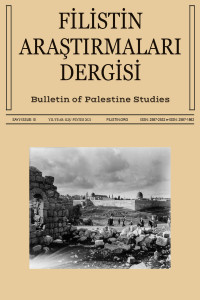The Question of the Privatization of Jerusalem Waqf Land: The Land of Bethlehem and Beit Jala as a Case Study since 1950
Bu çalışma, Kudüs'teki İslami vakıf yönetimi ile Bethlehem ve Beit Jala'nın Hıristiyanları arasındaki toprak mülkiyeti üzerine olan uzlaşmazlıkları aydınlatmaya çalışmaktadır. Bu uzlaşmazlık bu insanların ellerindeki arazilerin İslami vakıf olduğunu kabul etmeyi reddetmesi üzerine 20. yüzyıl ortalarında ortaya çıkmıştı. Bu anlaşmazlığı temel alan çalışma çatışmanın tarihsel köklerini izleyerek bu hukuki konu hakkında alınacak bir mahkeme kararına kadar konuyu açıklamaya çalışmaktadır. Araştırmanın temel soruları ise şunlardır: Bu dönemde taraflar arasındaki anlaşmazlığın kaynağı nedir? Daha önce neden görünmedi? Dini farklılığın bu çatılmada bir rolü var mıdır? Veya kişisel ve maddi menfaat meselesi mi?
Anahtar Kelimeler:
Kudüs, Vakıf, Vakıf hukuku, Özelleştirme, Toprak Mülkiyeti, Arazi hukuku, Beytüllahim, Vakıf İdaresi, Hıristiyan Nüfus
The Question of the Privatization of Jerusalem Waqf Land: The Land of Bethlehem and Beit Jala as a Case Study since 1950
This study tries to shed light on the conflict between the Islamic waqf administration in Jerusalem and the Christian population of both Bethlehem and Beit Jala over the land ownership in these two cities. This conflict emerged in the mid-twentieth century after these people refused to recognize that the land in their possession is an Islamic waqf and not private property. Based on this, this study attempts to shed light on this legal issue by tracing the historical roots of this conflict until it was taken to the court for a decision. The main question in this research is: What is the origin of the dispute between the two parties at this particular time? Why did it not appear before this date? Does the difference in religion have a role in this conflict? Or is it a matter of personal and material interests?
Keywords:
Jerusalem Waqf, Waqf legislation, privatization, land property, property law, Bethlehem, Waqf administration, Christian population, legal conflict,
___
- al-Asalî, Kâmil Jamîl, 2009, Min Âthâruna fî Bayt al-Maqdis. Amman: Wizârat al-Thaqâfa, p. 28-29. ‘Ashûb, Abd al-Jalîl, 1935, Kitâb al-Waqf, 2 edition, al-Qâhira, Maṭba‘at al-Rajâ. al-Ḥusaynî, Muḥammad As‘ad, 1982, al-Manhal al-Ṣâfî fî al-Waqf wa Aḥkamah, al-Quds, al-Maṭba‘at al-waṭaniyya. Muḥîbish, Ghasân, 2004, Waqfiyyat Khaṣṣakî Sultan Waqf: Dirâsa wa taḥlîl. unpublished Ph.D Dissertation, Ein Shams University. Myres, David, 2000, « al-‘Imara al-‘Amira the Charitable Foundation of Khassaki Sultan (959/1552) » in Sylvia Auld (éd.), Ottoman Jerusalem : the Living City : 1517-1917, London, Altajir World of Islam Trust, vol. 1, p. 539-583. Peri, Oded, 1992, « Waqf and Ottoman welfare policy : the Poor kitchen of Hasseki Sultan in eighteenth-century Jerusalem », Journal of Economic and Social History of the Orient, vol. XXXV, part 2, p. 167-185. Qadrî Bâshâ, 1928, Qânnûn al-‘adl wal-inṣâf lil-qaḍâ’ ‘alâ Mushkilât al-awqâf, al-Qâhira, article 3. Shûka, Khalîl. 2000. Târîkh Bayt Laḥîm fî al-‘Ahd al-‘Uthmânî, Bayt Laḥim. Singer, Amy, 1997, « The Mülknâmes of Hürrem Sultan’s waqf in Jerusalem », in Gülru Necipoglu (éd.), Muqarnas : an Annual on the Visual Culture of the Islamic World, Leiden, Brill, p. 96-102. Singer, Amy, 2002, Constructing Ottoman Beneficence : an Imperial Soup Kitchen in Jerusalem, NewYork, University of New York Press. Singer, Amy, 2003, « The Privileged Poor of Ottoman Jerusalem », in Jean-Paul, Pascual (dir.), Pauvreté et richesse dans le monde musulman méditerranéen, Paris, Maisonneuve et Larose, p. 257-269. Sroor, Musa, Fondation Pieuses en Mouvement : De la Transformation du statut de Propriété des biens waqfs à Jérusalem 1858-1917, Aix-en-Provence et Damas, IREMAM et Ifpo, 2010. Sroor, Musa, 2012, « The Role of the Islamic Pious Foundations Waqf in Building the Old City of Jerusalem during the Islamic Periods 637-1917», in Robert Carvais (ed.), Nuts & Bolts of Construction History, Culture, Technology and Society, Paris, Picard, Vol. 2, p.229-237. Sroor, Musa, 2012, «Dawr al-Awaqâffî al-Tanmiyya al-‘Umraniyyafî al-Quds», Majalat Ḥawliyyat al-Quds, N. 14. P. 64-71. Stephan, ST. H., 1944, « An Endowment Deed of Khasseki Sultan Dated 24th may 1552 », The Quarterly of the Department of Antiquities in Palestine, vol. 10, p. 170-194.
- Yayın Aralığı: Yılda 2 Sayı
- Başlangıç: 2017
- Yayıncı: Muhammed Mustafa KULU
Sayıdaki Diğer Makaleler
Selim Tezcan, Mehmet Sadık Gür, Alper Sarıbaş
Kudüs şehrinin Filistin, İsrail ve Birleşmiş Milletler açısından siyasi önemi
The Birth of the Jerusalem Sanjak (Kudüs mutasarrifliği)1864-1914: Administrative and Social Impacts
Halilürrahman’ın Dura Köyünde 1863 Yılında Yaşanan Bir Aşayiş Meselesi
Demir Çağı Yazılı ve Arkeolojik Kaynaklarında İsrail ve Yahuda Krallıkları
